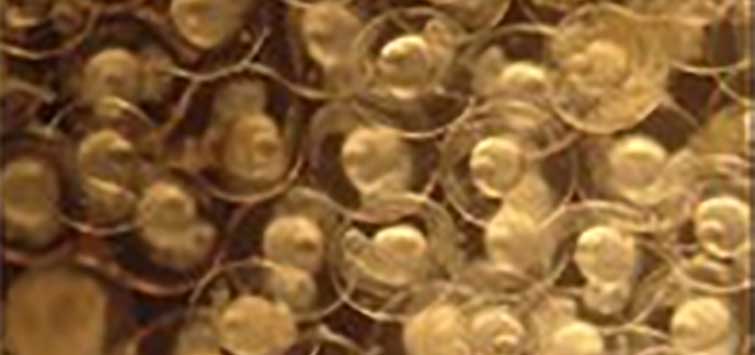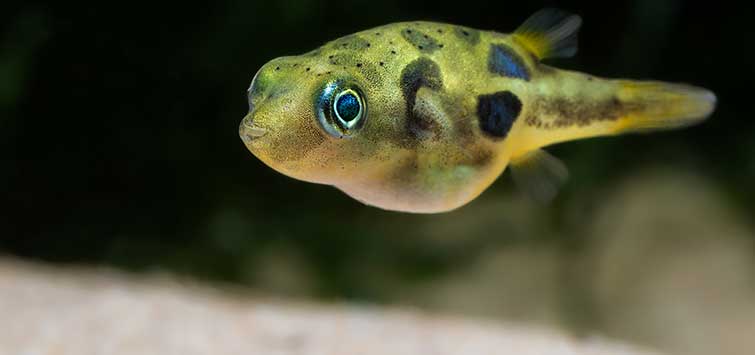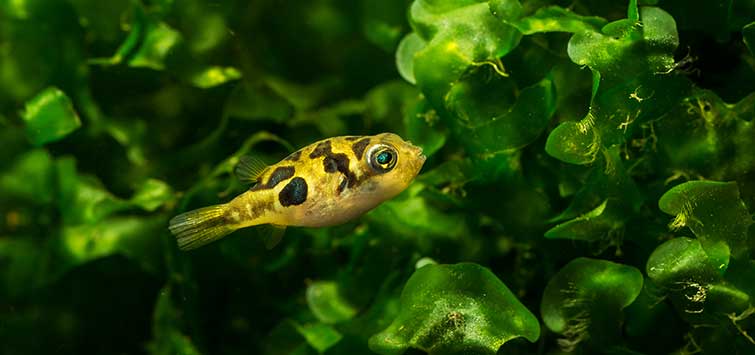Breeding and Raising Arrowhead Puffers
Author: Karina Schoopp Jensen
An account of how the author was able to successfully breed the arrowhead puffer Tetraodon suvattii and raise up the fry.
New Breeding Frontiers
It’s not often that puffers are bred by an aquarist. The arrowhead puffer Tetraodon suvattii can be bred, but it is very difficult because of their aggressive behavior. I was lucky enough to successfully spawn this puffer and raise the babies, however, and the following is an account of how it was done. I believe I am the first to breed arrowhead puffers, at least here in Denmark.
Aquarium Setup
First of all, you need a pair of puffers and an aquarium with a piece of slate or other firm rock where they can lay their eggs. The first challenge is to select a male and a female, which can be difficult, since there is no known way to see the difference between the sexes in this species. The female I have is a little larger than the male, but that can be due to a difference in age, food, genetics, or something else. You have to have some luck to breed this fish; you have to be lucky in getting a pair, and you also have to be lucky with keeping them alive in the same tank.
The aquarium should be decorated in such a way that the puffers can swim and rest on the bottom without seeing each other, and in this way they won’t fight and harm each other as much. It is very important that lines of sight are broken up as much as possible.
Feed the puffers well with meaty foods like whole defrosted shrimp in the shell, pieces of fish, and chunks of shellfish, and make sure your filtration and water changes are up to the challenge.
Arrowhead Puffer Spawning
Courtship turns these nasty fish into sweethearts. A fish that was once very aggressive can now be most loving and considerate to its mate. Much of courtship consists of the pair lying on the bottom together for days, but they do have periods where they puff up, distend their tails, and swim slowly around each other near the chosen spawning site. Occasionally they will lay eggs after less than a day of courting, but most of the time my arrowheads have laid eggs after a courting period of two to four days. During this time, the fish keep the site clean by blowing at it with great force, removing any foreign material that has settled on the rock.
Once the eggs are laid and fertilized, the male hovers over the eggs and fans fresh water over them. He also gently removes any eggs that have fungus. He stands guard day and night for 9 to 12 days until all of the eggs hatch. While the male stands guard the female keeps out of sight because the male is very protective and aggressive.
Hatching
You can very clearly see how the eggs develop. From day four the larvae are visible, and from this point on you can see development progress inside the eggs every day. Actually, you can even notice a change from morning to afternoon.
Hatching happens over a period of three to five days. This long hatching period creates difficulties because the fry will differ in size depending on when they hatch. But the lengthy hatching period isn’t all bad; it helps because you have a couple of days to catch the fry and potentially make adjustments in the fry aquarium if the first fry die.
If you leave the fry with the parents they will all disappear within three days. I guess it is possible the adults eat them, but I think the fry die because there is no way to provide them with enough food, nor the proper water quality in the spawning tank.
Just before a fry swims away from the slate, you can see its tail sticking out from the egg. The fry, shaped like a ball with a tail, wriggles a few times until it escapes and swims away. You might think the “ball” is its yolk sac, but since it seems like the fry eat within a few hours of hatching, I don’t think it is a yolk sac, but instead just the typical shape for puffer babies.
Establishing a Rearing Tank
The fry aquarium can be a relatively small one to start. A 12-liter (3-gallon) tank of fresh water mixed with a little water from the parents’ aquarium will work. Keep the temperature about 26° to 27°C (79° to 81°F). Also put an air-driven filter and an airstone in the aquarium. I have found that arrowhead puffers like a relatively high oxygen content. In the beginning, set the airstone to have three to five air streams rising; it’s not much, but together with the filter it’s enough to give a little movement in the water without the fry being blown around the tank.
Plants are great, but don’t add so many that you won’t be able to easily keep the aquarium clean. The bottom should be cleaned once or twice a day. When the fry get a little older, plants will be more necessary because the fry can hide from each other in them. Plants also contribute to good water quality. I always try to have plants that can take lots of nutrients from the water.
I put a little sodium benzoate in the water to keep the fry from getting fungus. [Sodium benzoate is not commonly available in the US; perhaps another antifungal agent could be substituted—Eds.] The fry rest a great deal on the bottom, and the first fry I tried to raise got fungus and died the second night, so again, I was glad that the fry hatched over four days.
Feeding the Fry
Now comes the hard part, although it might not be that hard when you know what to expect. In the beginning the fry only eat live food. They can eat really large amounts, and they don’t seem to bother eating food that is too small, therefore you have to have different sources of live food at different stages of their growth.
At hatching the fry are big enough to eat infusoria and brine shrimp, but they are a bunch of hungry little eating machines, so it can be difficult to produce enough brine shrimp. I supplemented with infusoria and a liquid fry food. At first the fry should be fed as often as possible, which should be about six to eight times per day. Slowly reduce the feeding to two to three times a day.
As the fry grow, you can give them such prey items as daphnia (at about four or five days of age), black and red mosquito larvae (after about a week), and other live animals and small fish. Don’t be afraid to challenge the fry and try different kinds of food to see what they can handle. In general you don’t have to be afraid to give them food that seems too large, as the fry can eat astonishingly large live foods.
Managing Aggression
After feeding, the fry themselves are the biggest challenge. They will not be very old before you see the first aggressive behavior among them—I have seen it in five-day-old fry! It is important to try and reduce their aggression in whatever way possible. Hiding places, lots of space for each fish, and full bellies are three good rules to go by.
They can stay close together peacefully and eat side by side with no problems, and then at other times they rush out and bite each other. You will often see babies missing part of their tails. I think there are two reasons for this outcome. First of all, the fry chase anything that moves, apparently without considering the size of the object they’re chasing. Second, it seems like they develop territorial feelings very early on and will defend their personal space from intruders. You can see how important the aquarium decoration and volume are as the fry grow.
If aggression is managed properly and water changes and other requirements are kept up, the arrowhead puffer is a special fish that can bring joy to the lives of their keepers. Breeding these puffers requires a lot of time and effort, since the fry are very aggressive and it is hard to determine the gender of the fish when obtaining them. However, while it’s very rare to spawn this wonderful fish, it is possible—and it’s quite the experience!

.png?h=595&iar=0&w=2781&hash=5FD5E69473BCC22199FBFA2FB71B6033)



